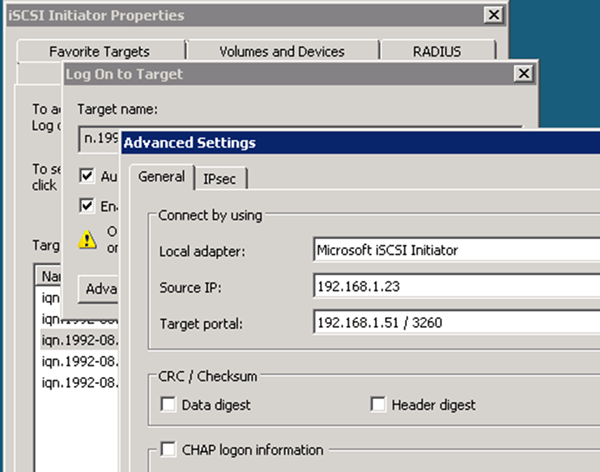Start iSCSI sessions with the target
 Suggest changes
Suggest changes


The Windows host must have an iSCSI connection to each node in the cluster. You establish the sessions from the host by using the iSCSI Initiator Properties dialog box on the host.
You must know the IP address of an iSCSI data LIF on the storage virtual machine (SVM) that contains the LUN you are accessing.
In ONTAP, the iSCSI host must have paths to each node in the cluster. The native DSM selects the best paths to use. If paths fail, the native DSM selects alternate paths.
The buttons and labels in the iSCSI Initiator Properties dialog box vary between versions of Windows. Some of the steps in the task include more than one button or label name; you should pick the name that matches the version of Windows you are using.
-
Open the iSCSI Initiator Properties dialog box:
For… Click… Windows Server 2012
Server Manager > Dashboard > Tools > iSCSI Initiator
Windows Server 2008
Start > Administrative Tools > iSCSI Initiator
-
On the Discovery tab, click Discover Portal or Add Portal, and then enter the IP address of the iSCSI target port.
-
On the Targets tab, select the target you discovered, and then click Log on or Connect.
-
Select Enable multi-path, select Automatically restore this connection when the computer starts or Add this connection to the list of Favorite Targets, and then click Advanced.
-
For Local adapter, select Microsoft iSCSI Initiator.
The following example is from Windows Server 2008:

-
For Source IP or Initiator IP, select the IP address of a port on the same subnet or VLAN as one of the iSCSI target LIFs.
-
Retain the default values for the remaining check boxes, and then click OK.
-
On the Targets tab, select the same target again, and then click Log on or Connect.
-
Select Enable multi-path, select Automatically restore this connection when the computer starts or Add this connection to the list of Favorite Targets, and then click Advanced.
-
For Source IP or Initiator IP, select the IP address of a different port on the subnet or VLAN of a different iSCSI target LIF.
-
For Target portal, select the IP address of the iSCSI target LIF that corresponds to the port you just selected for Source IP.
-
Retain the default values for the remaining check boxes, and then click OK.
-
Repeat steps 8 through 12 to connect to each target LIF that is available.


